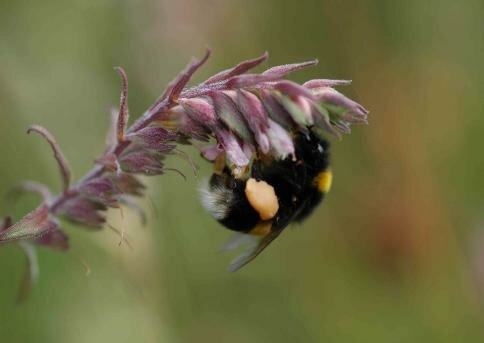|
|
|
|
|
|
|
|
|
|
|
|
|
Bumblebees in Crisis! |
|
In recent years it has become apparent that
|
|
 |
Bumblebees are fascinating and beautiful creatures that deserve conserving in their own right. However, there are also pressing ecological and economic reasons to halt their declines. Bumblebees are major pollinators of a majority of our flora. If bumblebees continue to disappear these plants will set less seed, potentially resulting in gradual but sweeping changes to the countryside. It may ultimately become dominated by an entirely different suite of plants that do not require bumblebee pollination. Clovers, vetches, and many rare plants may disappear. Indeed, there is evidence that this process is already underway. These changes will have catastrophic knock-on effects for other wildlife dependent on these plants. As such, it is often argued that bumblebees are keystone species, and that they are a conservation priority. |
|
Bumblebees are also of commercial importance, being vital to the agricultural industry. Many arable and horticultural crops depend on bumblebees for pollination to varying degrees. Some, like oilseed rape, can set adequate seed without bumblebees provided there are sufficient honeybees, but others, such as broad, field and runner beans and raspberries are heavily dependent on bumblebees. Without them there would be little or no crop to harvest. There is already evidence that in some regions where fields are large and there are few hedgerows (in which bumblebee queens forage in spring and build their nests) crop yields are depressed due to a shortage of bumblebees. |
|
|
|
It is thus essential that we take steps to conserve our remaining bumblebee populations, and if possible restore them to something like their past abundance. This cannot be achieved with existing nature reserves. Bumblebee nests are large, containing up to 400 sterile workers, each of which travels more than 1 km from the colony in search of suitable flowers. Each nest needs many hectares of suitable flower-rich habitat, meaning that to support a healthy population which is viable in the long term, large areas of land must be managed sympathetically. UK nature reserves are simply too small. The only way to provide sufficient areas of habitat for bumblebees is if the wider farmed countryside and the vast areas covered by suburban gardens are managed in a suitable way. To do this we need to educate people... We need to and encourage farmers to adopt wildlife friendly farming methods through uptake of the Entry Level Stewardship scheme (ELS). We need to support the replanting of hedgerows and the recreation of hay meadow and chalk grassland habitats. These activities will not be at the expense of farming, but will actually benefit it, by improving crop yields at the same time as enriching the countryside. Meanwhile, in gardens nationwide we need to use wildflowers and traditional cottage-garden plants.
|


